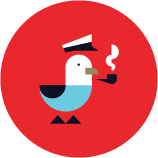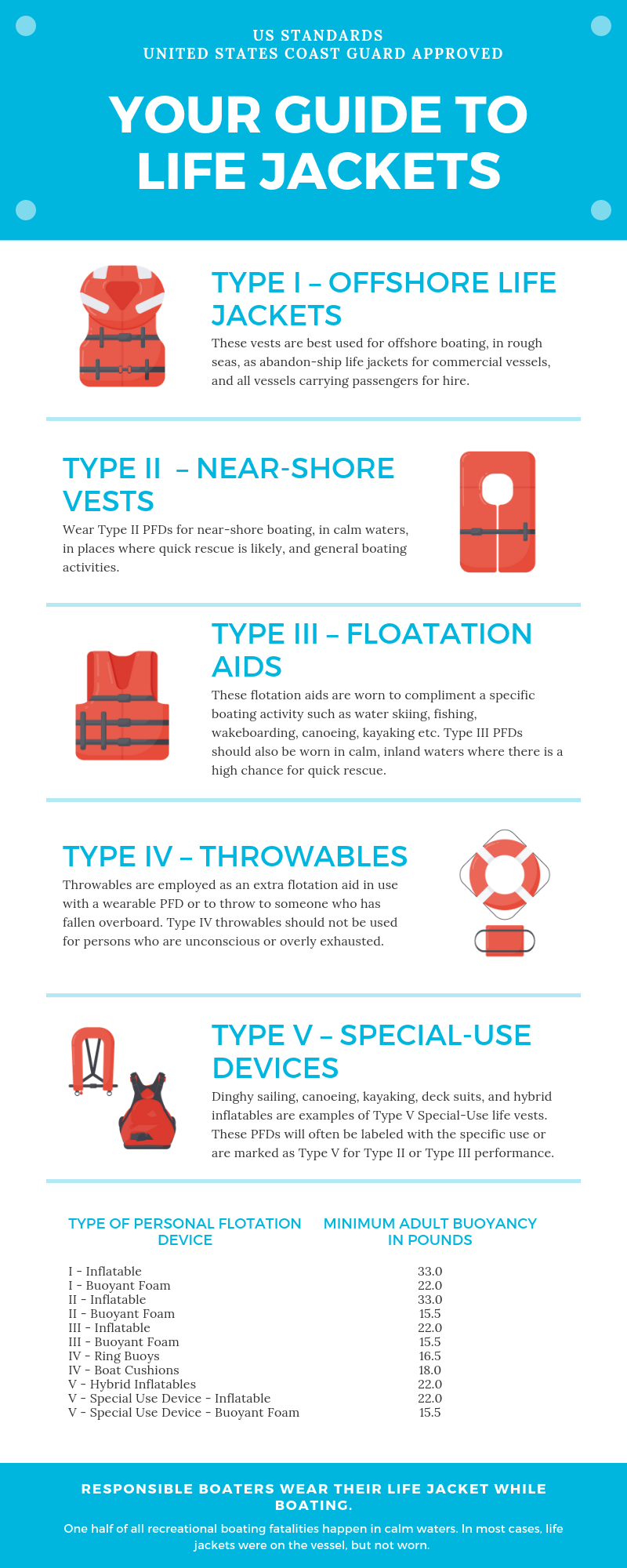Read on to learn more about 10 of the most popular boat models and what you can expect when making your big purchase.
Boating Safety: Coast Guard Approved Life Jackets
Post by Olivia Provencher-Hennedy - Published on 05/19/22 12:15 PM

Whether you’re a first-time passenger or a seasoned skipper, knowing what type of life jacket to have onboard and wear could save a life. PFDs vary by size and type, so in this post, we break down the differences between Type I - Type V, how to wear them, where to buy them, and how to care for your PFD.
For most boaters, ever-changing circumstances on the water are part of the fun and mean that preventative safety measures are always top of mind. Personal Flotation Devices (PFDs) are the most critical safety equipment you carry on your vessel, so it's crucial to understand the differences between them because not all life jackets are the same..
Want more boating safety tips? Check out our History of Mayday and other Boater Distress Calls post.
Please note that the following information regarding life jackets are US standards, approved by the United States Coast Guard..png)
Types of Life Jackets
Type I – Offshore Life Jackets 
Best used for:
-
Offshore boating
-
Open water
-
Rough seas
-
In waters where rescue may be slow coming
-
Abandon-ship life jacket for commercial vessels
-
All vessels carrying passengers for hire
Minimum Adult Buoyancy:
Inflatable: 33lbs
Buoyant Foam: 22lbs
Type II – Near-shore Vests 
Best used for:
-
Calm, inland waters
-
Good chance for quick rescue
-
General boating activities
Minimum Adult Buoyancy:
Inflatable: 33lbs
Buoyant Foam: 15.5lbs
Type III – Flotation Aids 
Best used for:
-
Calm, inland waters
-
Good chance for quick rescue
-
General boating activities
-
Specialized activities such as: waterskiing, hunting, fishing, canoeing, kayaking, wakeboarding, etc.
-
Designed for wearing the life jacket to compliment the boating activity
Minimum Adult Buoyancy:
Inflatable: 22lbs
Buoyant Foam: 15.5lbs
Type IV – Throwables 
Best used for:
-
Throwing to someone who has fallen overboard
-
Extra flotation in use with a wearable PFD
-
Note: throwables should not be used for persons who are unconscious or exhausted
Minimum Adult Buoyancy:
Ring Buoys: 16.5lbs
Boat Cushions: 18lbsType V – Special-use Devices

Best used for:
-
Canoeing/Kayaking
-
Deck Suits
-
Sailing
-
Inflatable overhead jackets with harness
-
Overhead entry foam for dinghy sailing
-
Hybrid Inflatables
-
Note: Type V vests will often be labeled with the specific use or are marked as Type V for Type II or Type III performance.
Minimum Adult Buoyancy:
Hybrid Inflatable: 22lbs fully inflated / 7.5 deflated
Special Use Device - Inflatable: 22.0 to 34.0
Special Use Device - Buoyant Foam: 15.5 to 22.0-1.png)
How to wear your life jacket / PFD
This may sound obvious, but try on your recreational life jacket before using it on the water. All zippers, straps, and buckles should fasten securely, and your life jacket should be snug and comfortable.
In years past, PFDs could be bulky and restricting, but new design styles eliminated that discomfort. You mustn't alter your life vest to make it fit better – alterations will decrease its ability to protect you adequately, so shop around and find what's best for you and your type of boating activity.
Lastly and most importantly: For your life jacket to protect you, you must wear it. -2.png)
Life jacket / PFD Maintenance
Did you know that it’s a law that your life jacket must be in good condition before boarding a vessel? Proper care of your PFD will make it last longer and help it protect you better. So double-check and make sure that everything's ship-shape before untying from the dock. Below are some quick tips for extending the life of your PFD.
-
Let it air dry. Never dry with a heater or any direct heat source.
-
Rinse with fresh water.
-
Avoid stowing life jackets in the boat for long periods when the vessel isn't used.
-
Please don’t use them as fenders or kneel on them; PFDs lose buoyancy when crushed.
-
Check your PFD regularly for tears, holes, or any damage. Water-logging, mildew odor, or shrinkage of the buoyant materials means it’s time for a new one.
Where to buy your PFD
Any sporting goods store, marina shop and of course online. Life jackets will vary in price depending on type, material, and size. Some of our personal favorites include West Marine, REI, and Mustang Survival.-2.png)
Life jackets for dogs
The team here at Dockwa loves to bring our pups out on the water, and judging from our Best Boat Names categories, Dockwa boaters do too. However, even if your dog is a good swimmer, things like a strong current, terrible weather conditions, fatigue, and general distractions on the water, could potentially harm your pet. When you're on or around the water, having your dog in the life vest prevents the likelihood of an incident occurring.
There is a variety of doggie PFDs out there, so before choosing one, here are some things to consider:
-
Weight and size of your dog. Comfort is important for their safety too!
-
Do you prefer a handle on the back so it's easy to attach a leash?
-
Proper head and neck support is important to help keep their head above water.
-
Is it easy to put on and take off? No one wants to wrestle with a wet dog.
-
Durability. We find that nylon fabric stands up to the elements, is rip-resistant, and easy to clean.
-
Breathability. Life vests, if worn out of the water for too long, can cause your pup to over heat. Make sure to snag a PFD that has a light weight and durable fabric to keep your dog cool.
Half of all recreational boating fatalities happen in calm waters. In most cases, life jackets were on the vessel, but not worn. Click the image to the left to download your printable life jacket guide so that you're always prepared.
What other boating guides, terminology, tips, and tricks do you like learning about? Let me know at marketing@dockwa.com or post in our Facebook Group.
Check out our other blog posts to get an inside look at our favorite destinations, marinas, liveaboards, and tips for boaters. Then, join the conversation on Flipboard, Facebook, Twitter, and Instagram.






